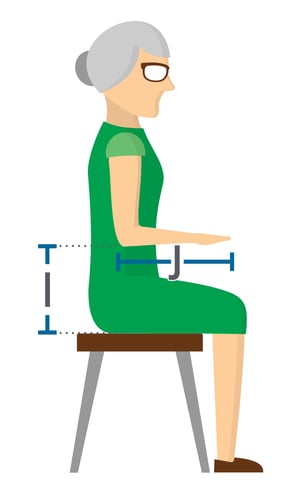Part 13 in our LTC Seating & Positioning series intended to shed some light on the mystery of seating and positioning in the LTC setting. See the rest of the blog posts in the following links: Part 1 (Best Wheelchair Options in LTC), Part 2 (Posture Problems), Part 3 (Posterior Pelvic Tilt), Part 4 (Anterior Pelvic Tilt), Part 5 (Pelvic Obliquity), Part 6 (Pelvic Rotation), Part 7 (Fixed vs Flexible Postural Abnormalities), Part 8 (Windswept Posture), Part 9 (Incorrect Seating Dimensions), Part 10 (Issues with Current Wheelchair System: Seat-to-Floor-Height), Part 11 (Issues with Current Wheelchair System: Back Support), Part 12 (Issues with Current Wheelchair System: Legrest)
Looking for more information on seating and positioning? Check out our digital, rehab-focused Wheelchair Seating & Positioning Guide here.
If you had to guess, which one wheelchair system component receives the least amount of attention when it comes to ensuring proper fit with the patient’s body? We as therapists often perseverate on the cushion style, trial various head supports, and search for the best back support to ensure a well-fitting wheelchair system to promote optimal alignment and stability. The one component we can miss, however, is the armrest height. In my opinion, it receives too little attention. An ill-fitting armrest can increase the risk of an individual sliding into one of the abnormal postures in his/her wheelchair. And creating abnormal postures in turn causes other serious problems.
Armrests act as so much more than just a place to rest the upper extremity. Armrests:
- Add length when needed to support the UE optimally
- Add additional postural support especially at the trunk
- Decrease contracture risk by optimally aligning the joints of the UE
- Decreased dependent edema
- Maximize comfort while sitting in the wheelchair.
Often, the patient seeks out the armrest for stability especially when trunk control and strength are compromised due to prolonged sitting in a wheelchair system. As fatigue sets in, the person may slide down, lean over, or slump forward to make better contact with the armrest to feel safe and stabilize themselves when the musculature has lost the ability to do so for them. When an armrest or arm support is not adjusted properly, the patient will compensate and body alignment will be compromised. Patients may slide into one of the following abnormal postures to seek out contact with the armrest:
- Lean into a pelvic obliquity
- Slide into a posterior pelvic tilt
- Twist into a pelvic rotation.
Please refer to the charts below to take a closer look at specific armrest issues your resident could be having in relation to improperly adjusted armrest height.
|
HEIGHT: TOO LOW
|
||
| What is going on? | Negative Result | What can you do? |
|
Resident slides down in chair to make contact with armrests |
Posterior pelvic tilt with kyphosis of the thoracic spine |
Measure seat-to-elbow and adjust armrest height accordingly |
| Resident leans to one side seeking more support, pelvis on that side will be lower | Pelvic obliquity with scoliosis of the spine |
Measure seat-to-elbow and adjust armrest height accordingly |
| Excessive shoulder depression to make contact with armrest allows gravity to pull at shoulder joint | Shoulder subluxation and dislocation in a resident with weak shoulder musculature |
Measure seat-to-elbow and adjust armrest height accordingly |
|
HEIGHT: TOO HIGH
|
||
| What is going on? | Negative Result | What can you do? |
| Excessive elevation of shoulder to place arms on armrests | Constant contraction of musculature causes fatigue, pain, numbness, and contracture risk |
Measure seat-to-elbow and adjust armrest height accordingly |
| Resident leans against armrest versus placing arm on armrest seeking stability | Lateral leaning of trunk |
Measure seat-to-elbow and adjust armrest height accordingly |
| Resident leans to one side causing the pelvis on that side to be lower |
Pelvic obliquity with scoliosis of the spine |
Measure seat-to-elbow and adjust armrest accordingly |
*Use a MWC with armrest adjustability: K0004
We must always remember to measure for appropriate armrest height if we want an optimally fitted seating system that will match our patient’s very individualized need.

How to Measure Height (I):
- Seat your resident with shoulder in neutral and elbow bent at his or her side to 90 degrees
- Measure from top of seat to under forearm/elbow
*K0001, K0002, K0003 chairs DO NOT come wiht height adjustable armrests. This is just one more reason they are NOT the most cost-effective option when thinking long term.
- If resident is needing a specialized arm length (J): measure from end of elbow to where the therapist wants the desired replacement arm support to end
When all other factors have been considered but your patient still presents in one of the abnormal postures, think back to this blog and recall the importance of armrest height. When properly fitted armrest height is ignored, we should not be surprised by unwanted postures, which could lead to falls or the development of a pressure injury!
Please refer to the Seating and Positioning Guide to see what measurements need to be taken to ensure an accurately fitted wheelchair system!

Ana Endsjo, MOTR/L, CLT
Clinical Education Manager LTC Division
Ana Endsjo has worked as an occupational therapist since 2001 in a variety of treatment settings. She has mainly worked with the geriatric population, dedicated to the betterment of the treatment of the elderly in LTC centers. Her focus has been on seating and positioning and contracture management of the nursing home resident. With this experience, her hope is to guide other therapists, rehab directors, nurses, and administrators through educational guides, blogs, webinars, and live courses in her role as Clinical Education Manager for the long term care division.

